Earth’s atmosphere is a gas shell that surrounds the planet, extending for a certain distance from its surface. The atmosphere covers the hydrosphere and part of the Earth’s crust, and its outer surface meets the near-Earth region of outer space.
The scientific disciplines of atmospheric physics, meteorology, and climatology are dedicated to studying the different aspects of the atmosphere. Atmospheric physics focuses on understanding the physical properties and processes of the atmosphere. Meteorology examines the short-term weather patterns and phenomena that occur in the atmosphere, while climatology explores long-term climate variations.
Physical characteristics
The atmosphere’s thickness measures approximately 120 km from the Earth’s surface. The total mass of air in the atmosphere is estimated to be around (5.1-5.3)-10 18 kg. Within this, the mass of dry air comprises 5.1352 ±0.0003-10 18 kg, while the total mass of water vapor averages 1.27-10 16 kg.
The molar mass of pure dry air is 28.966 g/mol, and the density of air at sea level is roughly 1.2 kg/m 3 . The pressure at sea level and 0 °C stands at 101.325 kPa. The critical temperature is -140.7 °C, and the critical pressure is 3.7 MPa. At 0 °C, Cp is 1.0048-10 3 J/(kg-K), while Cv is 0.7159-10 3 J/(kg-K). The solubility of air in water (by mass) is 0.0036% at 0 °C and 0.0023% at 25 °C.
Under “typical conditions” at the Earth’s surface, the following values are considered: a density of 1.2 kg/m3, a barometric pressure of 101.35 kPa, a temperature of 20 °C, and a relative humidity of 50%. These standards are important in engineering.
Composition of the atmosphere
Troposphere
The upper limit of the troposphere is around 8-10 km in polar regions, 10-12 km in temperate regions, and 16-18 km in tropical regions. The lower part of the atmosphere, which is the main layer, contains over 80% of the total mass of air and approximately 90% of the water vapor present in the atmosphere. The troposphere experiences strong turbulence and convection, leading to cloud formation and the development of cyclones and anticyclones. The temperature decreases as altitude increases, with an average vertical gradient of 0.65°/100 m.
Tropopause
The tropopause is a transitional layer between the troposphere and the stratosphere. It is the part of the atmosphere where the decrease in temperature with altitude stops.
Stratosphere
The stratosphere is a layer of the atmosphere that is found at altitudes ranging from 11 to 50 km. It is characterized by a minimal change in temperature in the lower layer (11-25 km) and an increase in temperature in the upper layer (25-40 km) from -56.5 to 0.8 °C. The temperature then remains constant at around 273 K (almost 0 °C) until an altitude of about 55 km. This region of constant temperature is known as the stratopause and marks the boundary between the stratosphere and the mesosphere.
Stratopause
The stratopause is the layer of the atmosphere that lies between the stratosphere and the mesosphere. It is characterized by a maximum temperature (around 0 °C) in the vertical temperature distribution.
Mesosphere
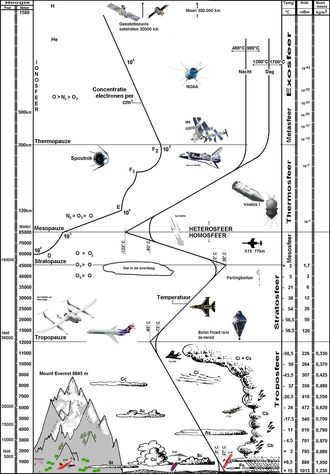

The mesosphere starts at a height of 50 km and stretches to 80-90 km. Temperature decreases as altitude increases, with an average vertical gradient of (0.25-0.3)°/100 m. Radiant heat exchange is the primary energy process. Atmospheric luminescence is caused by intricate photochemical processes that involve free radicals, vibrationally excited molecules, and so on.
A transitional region situated between the mesosphere and the thermosphere. It features a lowest point (approximately -90 °C) in the vertical distribution of temperature.
Karman line
The altitude above the Earth’s surface that is universally recognized as the demarcation between the atmosphere and outer space. As officially established by the FAI, the Karman Line is positioned 100 km above sea level.
Boundary of Earth’s Atmosphere
The demarcation of Earth’s atmosphere and ionosphere is commonly acknowledged to be at an elevation of 118 kilometers [1]. This determination is based on the examination of the movement characteristics of high-energy particles as they traverse through the atmospheric and ionospheric regions.
Thermosphere
The maximum altitude is approximately 800 kilometers. The temperature increases as we go higher, reaching around 1500 K at altitudes of 200-300 km, and then it remains relatively stable at higher altitudes. The ionization of the air, known as “aurora borealis” or “polar lights,” occurs due to the influence of ultraviolet and X-ray radiation from the Sun, as well as cosmic radiation. The ionosphere, where most of the ionization takes place, is located within the thermosphere. At altitudes above 300 km, atomic oxygen becomes the dominant component. The upper limit of the thermosphere is largely influenced by the solar activity. During periods of low activity, such as 2008-2009, the size of the thermosphere decreases significantly [2].
The area of the atmosphere next to the thermosphere above it. In this area, the absorption of solar radiation is negligible, and the temperature remains constant at all altitudes.
Exosphere (dispersion sphere)
The exosphere is the dispersal region, the outer portion of the thermosphere above 700 km. The gas in the exosphere is extremely sparse, and its particles leak into interplanetary space (dissipate) from here.
Below an altitude of 100 km, the atmosphere is a uniform and well-mixed blend of gases. In the upper layers, the vertical distribution of gases is influenced by their molecular masses, and the concentration of heavier gases decreases more rapidly as the distance from the Earth’s surface increases. As the density of gases decreases, the temperature also decreases, going from 0 °C in the stratosphere to -110 °C in the mesosphere. However, at altitudes of 200-250 km, the individual particles have kinetic energy that corresponds to a temperature of approximately 150 °C. Above 200 km, there are significant variations in temperature and gas density both in terms of time and space.
Between altitudes of 2000-3500 km, the exosphere gradually transitions into the near-space vacuum, which is filled with highly rarefied interplanetary gas particles, primarily hydrogen atoms. However, this gas only represents a portion of the interplanetary material present. The other portion consists of dust particles originating from comets and meteors. In addition to these extremely rarefied dust particles, this space is also permeated by electromagnetic and corpuscular radiation from the sun and galaxy.
The troposphere comprises approximately 80% of the atmosphere’s mass, while the stratosphere accounts for about 20%. The mesosphere’s mass is less than 0.3%, and the thermosphere makes up less than 0.05% of the total atmosphere mass. Based on electrical properties, the atmosphere can be further categorized into the neutrosphere and ionosphere. Currently, it is accepted that the atmosphere extends to a height of 2000-3000 km.
There are two main regions of the atmosphere that are distinguished based on the gas composition: the homosphere and the heterosphere. In the heterosphere, the separation of gases is influenced by gravity, as the mixing of gases at higher altitudes is not significant. This is why the composition of gases in the heterosphere can vary. Below the heterosphere is the homosphere, which is a well-mixed and homogeneous part of the atmosphere. The boundary between these two regions is known as the turbopause, which is located at an altitude of approximately 120 km.
At an altitude of 5 km above sea level, an individual without proper training experiences oxygen deprivation, leading to a significant decrease in their efficiency. This marks the boundary of the physiological zone within the atmosphere. Breathing becomes impossible for humans at an altitude of 9 km, even though oxygen is still present in the atmosphere up to approximately 115 km.
The atmosphere is responsible for providing us with the necessary oxygen for respiration. However, as the overall atmospheric pressure decreases with increasing altitude, the partial pressure of oxygen also decreases.
The human lungs always hold approximately 3 liters of alveolar air. The oxygen partial pressure in alveolar air is 110 mm Hg under normal atmospheric pressure, while the carbon dioxide pressure is 40 mm Hg and the water vapor pressure is 47 mm Hg. As altitude increases, the oxygen pressure decreases, while the total pressure of water vapor and carbon dioxide in the lungs remains relatively constant at around 87 mm Hg. When the pressure of the surrounding air reaches this value, the supply of oxygen to the lungs will cease entirely.
When the atmospheric pressure drops to 47 mmHg at an altitude of approximately 19-20 km, water and interstitial fluid in the human body start to boil. Death occurs almost immediately outside of a pressurized cabin at these altitudes. Therefore, from a human physiology perspective, “space” technically begins at an altitude of 15-19 km.
The dense layers of air in the troposphere and stratosphere provide protection against harmful radiation. However, at altitudes higher than 36 km, where the air becomes less dense, the body is exposed to intense ionizing radiation from primary cosmic rays. Additionally, at altitudes higher than 40 km, the ultraviolet part of the solar spectrum becomes dangerous for humans.
As we ascend higher and higher above the Earth’s surface, we begin to observe a gradual weakening and eventual disappearance of familiar phenomena such as sound propagation, aerodynamic lift and drag, and heat transfer by convection in the lower atmosphere.
In thin air layers, sound propagation becomes impossible. Controlled aerodynamic flight can still utilize air resistance and lifting force up to altitudes of 60-90 km. However, beyond altitudes of 100-130 km, the concepts of the M number and sound barrier, which are well-known to pilots, lose their significance. This is where the conventional Karman line is crossed, marking the start of a purely ballistic flight area that can only be controlled through the use of jet forces.
Formation of Earth’s Atmosphere: A Historical Perspective
Scientific theories propose that the Earth’s atmosphere has evolved through three distinct compositions throughout its history. Initially, the atmosphere was primarily composed of light gases, specifically hydrogen and helium, which were captured from interplanetary space. This phase, known as the primary atmosphere, occurred approximately four billion years ago. (Source: unspecified, 401 days ago).
As volcanic activity intensified, the atmosphere underwent a significant transformation, becoming saturated with gases other than hydrogen. These gases included carbon dioxide, ammonia, and water vapor, leading to the formation of a secondary atmosphere, which has persisted for approximately three billion years (326 days to the present day). This secondary atmosphere was characterized as a reducing atmosphere.
The formation of Earth’s atmosphere was influenced by various factors:
- The escape of light gases, such as hydrogen and helium, into interplanetary space;
- Chemical reactions take place in the atmosphere due to the impact of ultraviolet radiation, lightning discharges, and various other factors.
Over time, these factors have contributed to the development of a tertiary atmosphere, which is characterized by a lower concentration of hydrogen and a higher concentration of nitrogen and carbon dioxide. These gases are formed through chemical reactions involving ammonia and hydrocarbons.
Nitrogen
The production of abundant quantities of nitrogen N2 is a result of the oxidation of the ammonia-hydrogen atmosphere by molecular oxygen O2, which originated from the planet’s surface through the process of photosynthesis that commenced 3 billion years in the past. Nitrogen N2 is released into the atmosphere when nitrate and other nitrogen-containing compounds undergo denitrification. In the upper atmosphere, nitrogen undergoes oxidation by ozone, resulting in the formation of NO.
Nitrogen N2 undergoes reactions only in specific circumstances (such as lightning discharge). The process of oxidizing molecular nitrogen with ozone in the presence of electric discharges, albeit in small amounts, is employed in the industrial manufacturing of nitrogen fertilizers. Cyanobacteria, also known as blue-green algae, as well as nodule bacteria that form a symbiotic relationship with leguminous plants (referred to as siderates), are capable of oxidizing nitrogen with minimal energy usage and transforming it into a biologically active state.
The atmospheric composition underwent a significant transformation when living organisms emerged on Earth, thanks to the process of photosynthesis. This process involved the release of oxygen and the absorption of carbon dioxide. Initially, the oxygen was consumed to oxidize various reduced compounds such as ammonia, hydrocarbons, and the oxide form of iron present in the oceans. As this stage progressed, the oxygen levels in the atmosphere started to rise. Over time, the modern atmosphere with its oxidizing properties gradually took shape. This event, known as the Oxygen Catastrophe, had profound effects on numerous processes within the atmosphere, lithosphere, and biosphere.
Throughout the Phanerozoic era, the atmosphere experienced variations in its composition and oxygen levels. These changes were closely linked to the rate at which organic sedimentary rocks were being deposited. Consequently, during periods of coal accumulation, it is believed that the oxygen content in the atmosphere surpassed its current levels.
Carbon dioxide
The amount of CO2 in the atmosphere is determined by volcanic activity, chemical processes in the Earth’s shells, and most significantly, the intensity of organic matter synthesis and decomposition in the Earth’s biosphere. The Earth’s current biomass, which amounts to approximately 2.4-1012 tons, is primarily derived from carbon dioxide, nitrogen, and water vapor in the atmosphere. These organic materials found in the ocean, swamps, and forests undergo a transformation process and eventually become coal, oil, and natural gas.
Noble gases
Noble gases such as argon, helium, and krypton are primarily sourced from volcanic eruptions and the decay of radioactive elements. In comparison to space, the Earth and its atmosphere contain lower concentrations of these gases. This is attributed to the ongoing escape of gases into interplanetary space [source not stated for 326 days].
In recent times, human activities have had a significant impact on the evolution of the atmosphere. This is evident in the continuous and substantial rise in atmospheric carbon dioxide levels, primarily caused by the burning of hydrocarbon fuels that have accumulated over geological time. Photosynthesis and absorption by the world’s oceans play a crucial role in consuming vast amounts of CO2. The atmosphere also receives CO2 through the decomposition of carbonate rocks and organic matter from plants and animals, as well as from volcanic activity and human actions.
Over the past century, the concentration of CO2 in the atmosphere has increased by 10%, with the majority (360 billion tons) originating from fuel combustion. If the current rate of fuel combustion continues, the amount of CO2 in the atmosphere will double within the next 200-300 years, potentially leading to global climate change.
Combustion of fuel is a major contributor to the emission of harmful gases such as carbon monoxide (CO), nitrogen oxide (NO), and sulfur dioxide (SO2). In the upper atmosphere, sulfur dioxide reacts with oxygen from the air to form sulfur trioxide (SO3). This compound then combines with water vapor and ammonia to create sulfuric acid (H2SO4) and ammonium sulfate ((NH4)2SO4). These substances are then deposited onto the Earth’s surface as acid rain. The utilization of internal combustion engines results in significant air pollution from nitrogen oxides, hydrocarbons, and lead compounds (such as tetraethyl lead Pb(CH3CH2)4).
Aerosol pollution in the atmosphere is triggered by various factors, including natural phenomena like volcanic eruptions, dust storms, sea water droplets, and plant pollen. Additionally, human economic activities such as mining, fuel combustion, and cement production also contribute to aerosol pollution. The intensive transportation of particulate matter on a large scale into the atmosphere is considered one of the potential drivers of climate change on our planet.
Additional resources
- Air quality
- The atmosphere and climate
- Solar radiation and the atmosphere
- Atmospheric composition and structure
- Weather and climate patterns
- Atmospheric models and simulations
- Environmental impacts of atmospheric conditions
- Carbon cycle and its effects on climate
- Global warming and climate change
- Air pollution and its consequences
- Depletion of the ozone layer
- Greenhouse gas emissions and their impact
- Exploring outer space and its mysteries
References
Literature
- V. V. Parin, F. P. Kosmolinsky, B. A. Dushkov “Space Biology and Medicine” (2nd edition, revised and supplemented), Moscow: “Prosveshchenie”, 1975, 223 pp.
- N. V. Gusakova “Chemistry of the Environment”, Rostov-on-Don: Phoenix, 2004, 192 p ISBN 5-222-05386-5
- V. A. Sokolov “Geochemistry of natural gases”, Moscow, 1971;
- M. McEwen, L. Phillips “Chemistry of the atmosphere”, Moscow, 1978;
- K. Wark, S. Warner “Air Pollution. Sources and Control”, translated from English, 1980;
- Monitoring of background pollution of natural environments. in. 1, Leningrad, 1982.
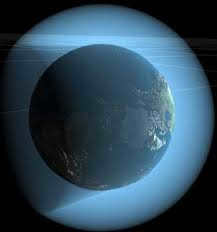
The Earth’s atmosphere is made up of various gases, with nitrogen being the most abundant, accounting for 78% of the entire atmosphere. Oxygen is the second most abundant gas, making up 21% of the atmosphere. The remaining 1% consists of other gases, including carbon dioxide.
Without the atmosphere, life on Earth would not be possible. The atmosphere plays a crucial role in regulating temperature, protecting the planet from harmful radiation, and providing the oxygen necessary for respiration.
The atmosphere can be divided into five different layers or spheres: the troposphere, stratosphere, mesosphere, thermosphere, and exosphere. Each of these layers has its own unique characteristics and plays a specific role in the overall functioning of the atmosphere.
Troposphere
The troposphere, also known as the lower sphere of the atmosphere, is the region where airplanes fly and where clouds are formed. It is also a habitat for birds.
Stratosphere
The stratosphere, the second layer of the atmosphere, has a crucial function. It acts as a shield against harmful ultraviolet rays from the sun, which can be extremely detrimental to living organisms.
Mesosphere [ ]
There are shimmering clouds present in this region.
Thermosphere [ ]
Exosphere [ ]
The exosphere is the uppermost layer. It is nearly the edge of outer space.
Gallery [ ]

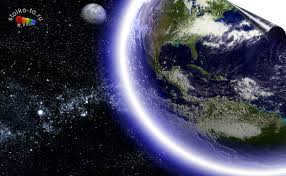
Other [ ]
- Earth’s atmosphere consists of nitrogen, oxygen, and various other gases;
- This planet’s atmosphere is divided into five spheres: tropo, strato, meso, thermo, and exo.
Basic concepts about climate
Climate Change: Climate change – Global warming – wildlife – caused by asteroid collision – Ideal climate (warmth) – Changing geography of the earth
Unique climate states: Climate without the Sun
Climate with indices
Arctic climate – Antarctic climate – Tundra climate – Taiga climate – Aquatic climate – Forest climate – Steppe climate – Desert climate – Humid equatorial climate – Garbage water climate – Tropical climate – Atmosphere (tropo – strato – Hydrosphere – Lithosphere ( Biosphere – Categories and Comments [ ]
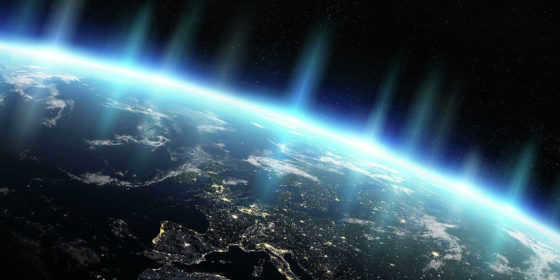
The gaseous shell surrounding a celestial object and separating it from outer space is known as the atmosphere. There are two types of atmosphere: planetary and stellar. They differ in terms of their structure, composition, and makeup. Among all stars, the atmosphere of the Sun has been extensively studied.
The stellar atmosphere is comprised of an outer shell that includes: light waves (photosphere), gases (chromosphere), and glowing plasma (corona). These elements combine to create the radiant glow that we observe.
The planetary atmosphere refers to the gaseous envelope that surrounds and is an integral part of a planet’s geospheres. It is held together by the planet’s magnetic field and rotates along with the planet, creating and sustaining a unique ecosystem on its surface. Among the celestial bodies in the solar system, Venus, Earth, Mars, and Saturn’s moon Titan possess well-defined gas envelopes. Other celestial bodies, on the other hand, are believed to have less distinct gas envelopes or none at all. The density and chemical composition of atmospheres vary, resulting in different internal climates on each planet. The atmosphere serves both protective and planet-forming roles.
What is the composition of the Earth’s atmosphere?
The Earth’s atmosphere is often described as a vast expanse of air surrounding our planet. It is a complex mixture of gases that envelops the Earth’s surface and is essential for supporting life. The atmosphere plays a crucial role in regulating the planet’s weather patterns and climate. In simple terms, it is the medium through which air circulates around the Earth in space. The existence of the atmosphere has been instrumental in the development of organic life on Earth. Furthermore, organic life has also had a significant impact on the composition and structure of the atmosphere.
The formation of the atmosphere initially occurred through the gravitational attraction of stellar particles and the influence of geological processes such as vaporization and volcanic eruptions. Only after the formation of the atmosphere did the oceans and biosphere emerge.

1263 5 20 Fascinating Sun Trivia
The Sun is a truly remarkable celestial body, and here are some interesting facts about it:
- All of the geospheres in our solar system are interconnected. Changes that happen in one planet can have a dramatic impact on the others.
- For instance, the original composition of Earth’s atmosphere, known as Proto-Earth, was vastly different from what it is today. The same can be said about the planet itself, which has undergone significant transformations over time.
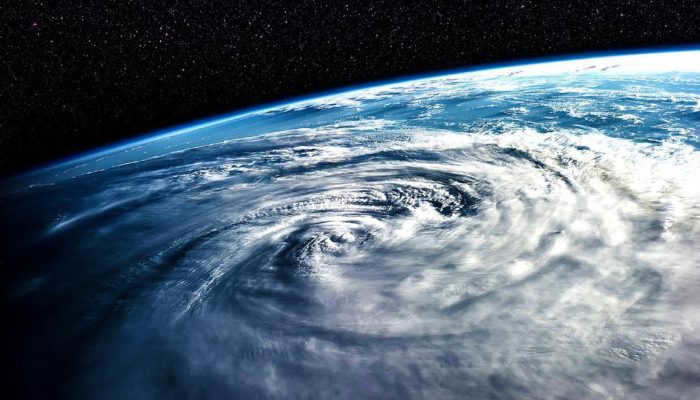

What is the composition of the Earth’s atmosphere?
The composition of the Earth’s atmosphere has undergone significant changes on at least four different occasions. Our atmospheric layer consists of a mixture of gases, dust, water in the form of vapor and ice crystals, minerals, bacteria, and various suspended particles. The total mass of the Earth’s atmosphere is 5.97×10²⁴ kg, which is equivalent to 5 quadrillion tons or one millionth of the Earth’s total mass. Approximately 50% of the total mass of the atmospheric envelope is concentrated within the lower 5 kilometers. Beyond that altitude, the air becomes lighter and less dense.
The gas composition of the Earth’s atmosphere near the surface is as follows:
- Nitrogen – 78%
- Oxygen – 21%
- Argon – 0.9%
- Carbon dioxide – 0.04%.
- Other gases (neon, helium, methane, hydrogen, xenon, and others) – 0.06%.
This represents the volumetric concentration of gases, and it is not constant. Lately, there has been an unstoppable increase in the carbon dioxide concentration in the atmosphere, altering its overall composition. Does this pose a threat of catastrophes and global warming? There is no definitive answer. Scientists are still fiercely debating. The oxygen content in the atmosphere is also unstable, which has environmentalists sounding the alarm.
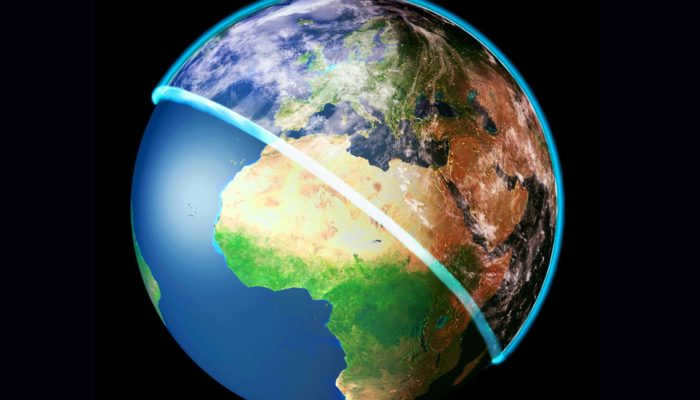

Properties of the Earth’s Atmosphere
As you move higher in the Earth’s atmosphere, there are changes in its physical and chemical properties. The state of the atmosphere is determined by various factors, including density, pressure, temperature, and composition of the air. For instance, as you go higher, both air density and humidity decrease, along with atmospheric pressure. On the Earth’s surface, the standard and optimal conditions for humans are an atmospheric pressure of 760 mmHg, an air density of 1.2754 kg/m³, a relative humidity of 50%, and a temperature of 20°C.
The atmosphere is composed of multiple layers, each with undulating boundaries. There is a categorization based on the presence of charged particles and the composition of gases (homosphere, heterosphere with a turbopause in between), as well as the impact on aircraft (dense layer, near-Earth space). Additionally, there are specific terms such as the ozonosphere (ozone layer), neutrosphere, ionosphere, radiation belt, dense layers, and free atmosphere.
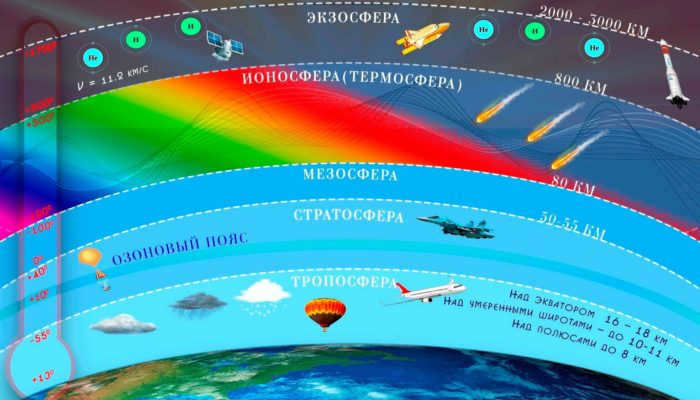

The Structure of Earth’s Atmosphere
Scientists have classified the Earth’s atmosphere into different layers based on their thermal properties. These layers experience changes in temperature due to various factors such as terrestrial and solar activity. There are also transitional layers known as pauses, which maintain a consistent temperature environment.
- The troposphere is the most compositionally diverse layer, spanning a range of 8 to 18 km depending on location, and containing about 80% of the atmosphere’s total mass as well as nearly all of its water vapor. It is heated from the Earth’s surface and gradually cools to a frigid -60°C. The troposphere is where the biosphere thrives, and it is here that air currents, cyclones, and anticyclones form, giving rise to clouds, precipitation, and the weather and climate conditions that shape our world. It is a skydiver’s paradise and the maximum altitude for civilian aircraft. The troposphere appears transparent, with faint misty patches.
- The tropopause is a transitional zone with a temperature of -55°C, serving as the boundary between the troposphere and the layer above.
- The stratosphere accounts for approximately 20% of the total mass of the air envelope and spans a range of 15-50 km above the Earth’s surface. It is within this region that the ozone layer, consisting of 90% ozone, is located, providing protection against harmful ultraviolet rays. While the temperature in the stratosphere initially drops to -50°C, it begins to rise towards zero upon reaching the ozone layer. This atmospheric layer is frequented by high-altitude combat aircraft and meteosondes, and is known for its blue hue.
- The stratopause refers to the transitional layer between atmospheric layers where the temperature reaches 0°C.
- The mesopause is a region with a temperature of 90 degrees Celsius.
- The Karman Line marks the boundary between Earth and space, situated approximately 100 kilometers above sea level. At this point, the atmosphere becomes extremely thin, making aerodynamic aviation unviable and signaling the beginning of space.
- The Thermosphere (also known as the hot layer) comprises only a small fraction, about 0.05%, of the total mass of the Earth’s atmosphere. It is primarily composed of atomic oxygen and is situated at altitudes ranging from 90 to 500-800 km. The temperature within this layer can reach as high as +1200°C; however, due to the thinness of the air, the heat is not physically felt. The Thermosphere is responsible for the formation of polar auroras and zarnitsa, as well as ionization processes. Additionally, a significant portion of the ionosphere is located within this layer. Notably, the Thermosphere is traversed by various satellites, including those used for topography, weather monitoring, GPS systems, and space stations. It is also home to man-made space debris, such as rocket remnants and inoperable satellites, which travel at speeds of approximately 35,000 kilometers per hour.
- The Thermal Pause represents another transition between atmospheric layers, characterized by temperatures nearing 1000°C.
- The outermost layer of the Earth’s atmosphere, known as the exosphere, is characterized by the presence of cosmic dust and a near-space vacuum formed by interplanetary gas. This layer is situated at an altitude of over 800 km above the Earth’s surface and extends up to 10,000 km into the vastness of space. Within the upper region of the exosphere, hydrogen atoms are present which have the capability to escape the Earth’s gravitational pull and venture into outer space, creating a scattering sphere. The exosphere is subject to intense solar radiation, resulting in temperatures ranging from 1200 to 2500°C. Beyond this point, lies the realm of absolute cosmic darkness and the beginning of near-Earth space.
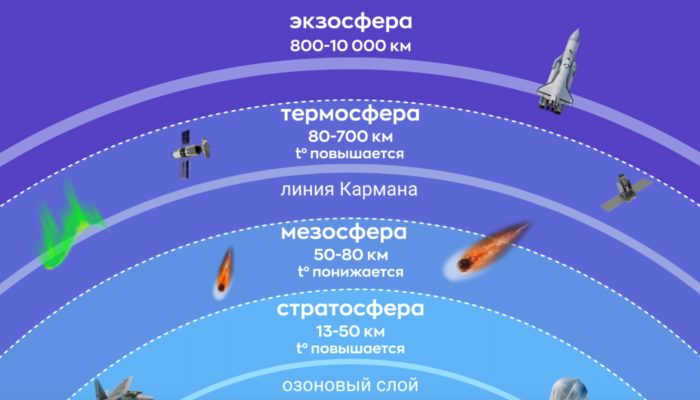
The lower part of the atmosphere is made up of the dense troposphere and stratosphere. In this region, there is turbulence, gravity, and friction, which allows airplanes to fly and space rockets to accelerate. These layers have a total height of approximately 50 kilometers.
The upper layers – namely the mesosphere, thermosphere, and exosphere – extend beyond 50 kilometers above the Earth and have very low densities. They serve as a smooth transition to interplanetary space.
The Earth’s atmosphere serves as our protective shield and home. It is thanks to the vast expanse of air enveloping our planet that we are able to experience the joys of life, breathe in the refreshing air, and marvel at the splendor of our Earth and the cosmos. The atmosphere plays a crucial role in maintaining stable weather patterns and climate conditions, fostering the growth and flourishing of all living beings. Additionally, it enables us to perceive and appreciate the sounds of our surroundings. The air contained within the troposphere is essential for the respiration of both humans and animals, as well as for facilitating chemical reactions.
Earth’s protective shield, the ozone layer, safeguards the planet against harmful ultraviolet radiation. Tiny celestial objects such as meteorites and debris, drawn by the force of gravity, disintegrate in the atmosphere without inflicting any harm or calamities, while the destructive solar wind diminishes in intensity. The condition of the atmosphere has a direct impact on the health and welfare of the inhabitants of Earth.
Pollution of Earth’s Atmosphere
The structure of the lithosphere, biosphere, and atmosphere is directly influenced by their interaction. While the scale of human economic activity is certainly not comparable to that of volcanoes on a protoplanet, we still contribute by extracting natural resources and engaging in industry and inorganic agriculture.
Through the burning of fuel, we release numerous polluting gases that cause acid rain and aerosol pollution. This pollution is not only caused by volcanoes and sandstorms, but also by the manufacturing of cement, building materials, mining, and agriculture.
Environmentalists frequently raise concerns about alterations in our atmospheric layer. The interplay between human activities and the air surrounding us is undeniable. In the hypothetical scenario where all forests on our planet were to be decimated and the living organisms responsible for the production and absorption of gases were eradicated, the very composition of our atmosphere would undergo a drastic transformation. Such an outcome would render the air unsuitable for human respiration, ultimately leading to fatal consequences.

All you need to know about the planet Mars 1263 4.79 7
Aside from the emission of carbon dioxide, vapor, and toxic smoke resulting from the incineration of waste, humans also contaminate the vastness of space with debris from spacecraft, leading to the formation of hazardous accumulations. It appears that we may not be adequately prepared to venture beyond Earth’s borders. After all, even in the limitless expanse of space, we will continue to create garbage dumps. Considering that individuals motivated by material possessions are not propelled by the wonders of space exploration, but rather the practical advantages it provides, it becomes apparent that even in these distant realms, humans will only contribute to the destruction of planets through the extraction of valuable minerals.
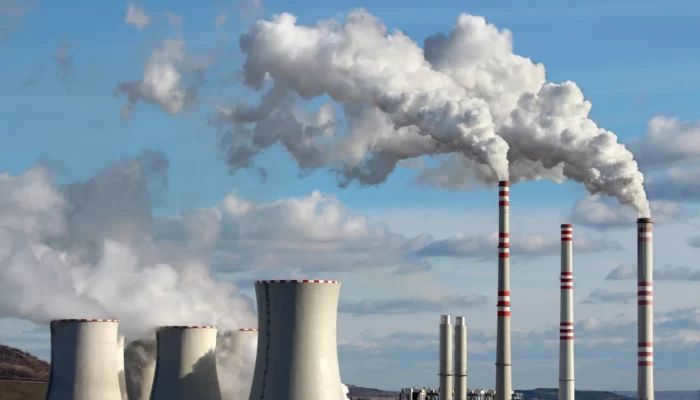
Scientists argue that the atmosphere is thinning and gaps are appearing in the ozone layer. The exact causes of these phenomena have yet to be determined, but there are numerous theories, with the most popular one suggesting that it is due to mankind’s irrational economic activities. Our actions are disrupting the natural equilibrium of processes in nature. Can we find a solution that will allow us to preserve the advantages we have gained through technological progress? Which path will we choose?
Our planet, the Earth, is our place of residence, and its protective covering is the atmosphere. It has the ability to transform from a stunning shade of sky-blue to a polluted and opaque state that blocks the sun’s rays. As a result, life and the environment on Earth will gradually fade away. Contemporary literature is filled with narratives about catastrophic occurrences triggered by alterations in the Earth’s atmosphere. Although these stories may seem fictional, they often contain elements of truth. This is why it is crucial for us to safeguard our own habitat and the shield that shields us.
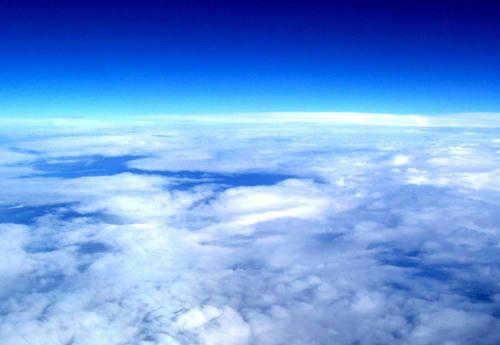

The Earth’s atmosphere is a layer of gas that surrounds our planet and moves in sync with its rotation. This gas is commonly referred to as air. The atmosphere is connected to the hydrosphere and covers a portion of the lithosphere. However, determining the exact upper boundaries of the atmosphere is a challenging task. It is generally accepted that the atmosphere extends upwards for approximately three thousand kilometers before gradually merging into the vacuum of outer space.
The process of atmospheric chemical composition formation started approximately four billion years ago. In the beginning, the atmosphere was predominantly composed of light gases such as helium and hydrogen. Scientists believe that the initial conditions for the establishment of a gaseous layer around the Earth were volcanic eruptions, which released a massive quantity of gases along with lava. Subsequently, there was gas exchange with bodies of water, living organisms, and the byproducts of their activities. Over time, the composition of the air underwent gradual transformations and took its present-day form millions of years ago.
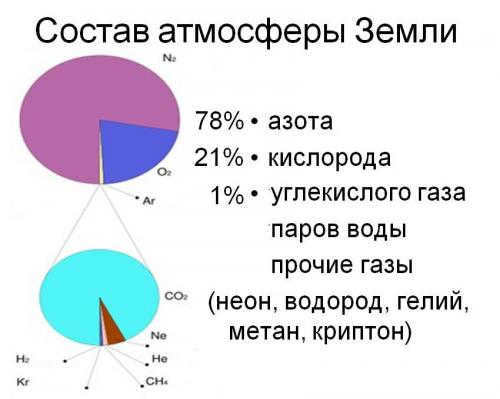
The Earth’s atmosphere is primarily composed of nitrogen, accounting for approximately 79% of its total composition, with oxygen making up around 20%. The remaining 1% consists of various gases such as argon, neon, helium, methane, carbon dioxide, hydrogen, krypton, xenon, ozone, ammonia, sulfur and nitrogen dioxides, nitrous oxide, and carbon monoxide.
Additionally, the atmosphere also contains water vapor as well as particulate matter, including plant pollen, dust, salt crystals, and aerosol impurities.
Lately, scientists have observed quantitative changes in certain air components rather than qualitative ones. And the primary cause for this phenomenon is human beings and their actions. In the past century alone, there has been a significant rise in the levels of carbon dioxide! This has dire consequences, with the most far-reaching being the alteration of climate patterns.
Formation of Weather and Climate
The formation of weather and climate on Earth is heavily influenced by the atmosphere. Several factors, such as the amount of sunlight, the characteristics of the Earth’s surface, and atmospheric circulation, contribute to this process.
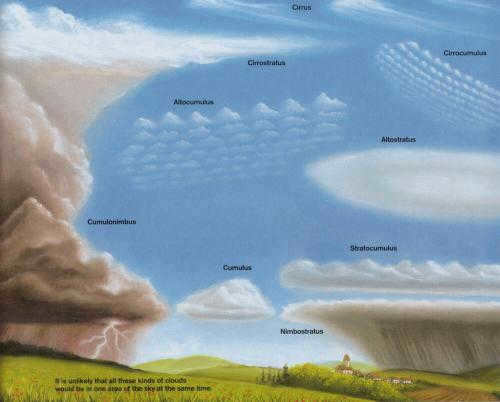
Let’s analyze the factors sequentially.
1- The Earth’s atmosphere permits the entrance of sunlight and absorbs harmful radiation. The ancient Greeks were aware of the phenomenon that sunlight falls on different parts of the Earth at varying angles. The term “climate” itself derives from the ancient Greek word for “slope”. Consequently, near the equator, sunlight falls almost directly, resulting in high temperatures. As one moves closer to the poles, the angle of sunlight inclination increases, leading to a decrease in temperature.
2. The atmosphere experiences air currents due to the uneven heating of the Earth. These currents can be categorized based on their scale. Local winds are the smallest (measuring tens and hundreds of meters). Following that, we have monsoons, trade winds, cyclones, anticyclones, and planetary frontal zones.
All these air masses are in constant motion, with some being relatively stationary. For instance, there are trade winds that flow from the subtropics towards the equator. The movement of other air masses, on the other hand, is largely determined by atmospheric pressure.
Atmospheric pressure is another crucial factor in the formation of climate. It refers to the pressure exerted by the air on the Earth’s surface. As we know, air masses tend to move from areas of higher atmospheric pressure to areas of lower pressure.
There are a total of 7 different climate zones on Earth. The first zone, known as the equator, experiences low atmospheric pressure. Moving away from the equator towards the thirtieth latitude on both sides, the pressure increases, resulting in a zone of high pressure. Once you reach the thirtieth latitude, the pressure decreases again, creating another zone of low pressure. Finally, from the sixtieth latitude up to the poles, there is yet another zone of high pressure. The movement of air masses between these zones plays a crucial role in determining the weather patterns.
When air currents blow from the sea towards the land, they bring with them moisture, resulting in rainfall and unfavorable weather conditions. On the other hand, when air currents blow from the continents, they bring clear and dry weather. The collision of air currents in certain areas gives rise to atmospheric front zones, which are characterized by precipitation and stormy, windy weather.
Researchers have established that atmospheric pressure has a direct impact on human well-being. According to global standards, the standard atmospheric pressure measures 760 mm Hg at a temperature of 0°C. This measurement is taken at locations that are nearly at sea level. However, as altitude increases, atmospheric pressure decreases. For instance, in St. Petersburg, the standard pressure is 760 mm Hg, whereas in Moscow, which is situated at a higher elevation, the standard pressure is 748 mm Hg.
Not only does pressure change vertically, but it also fluctuates horizontally, particularly during the passage of cyclones.
It’s like a layer cake, the atmosphere. Each layer comes with its own unique characteristics.
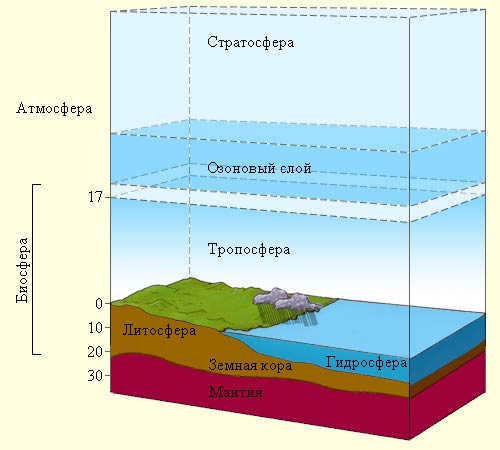

• The layer closest to the Earth is called the troposphere. The thickness of this layer varies depending on the distance from the equator. It extends upwards by 16-18 km above the equator, 10-12 km in temperate zones, and 8-10 km at the poles.
Within the troposphere, 80% of the total air mass and 90% of water vapor are contained. This is where clouds form and cyclones and anticyclones occur. The temperature of the air in this layer depends on the altitude. On average, it decreases by 0.65° C for every 100 meters.
• Tropopause – An intermediate layer in the atmosphere that ranges in height from a few hundred meters to 1-2 km. During the summer, the air temperature is higher compared to winter. For instance, over the poles in winter, it can reach as low as -65° C, while over the equator, it remains around -70° C throughout the year.
• The stratosphere – is a region in the atmosphere that extends up to 50-55 kilometers in altitude. Turbulence in this layer is minimal, and the presence of water vapor is almost negligible. However, the concentration of ozone is significantly high, peaking at around 20-25 kilometers above the Earth’s surface. In the stratosphere, the air temperature starts to increase and reaches approximately +0.8° C. This rise in temperature is attributed to the interaction between the ozone layer and ultraviolet radiation.
• Stratopause – A transitional layer between the stratosphere and the subsequent mesosphere.
• Mesosphere – The upper limit of this layer is 80-85 kilometers. Complex photochemical processes involving free radicals occur here, resulting in the delicate blue glow of our planet visible from space.
Most comets and meteorites disintegrate in the mesosphere.
• Mesopause – the following intermediate layer, where the air temperature drops to a minimum of -90°.
• Thermosphere – the lower boundary starts at an altitude of 80 to 90 km, and the upper boundary of the layer is around the 800 km mark. The air temperature rises, ranging from +500° C to +1000° C. Temperature fluctuations can reach hundreds of degrees within a day! However, the air in this layer is so thin that the concept of “temperature” as we understand it is not applicable here.
The upper layer of the ionosphere, which is situated at an altitude of 150-400 km, is the most crucial layer. Its distinguishing feature is its ability to reflect radio waves, enabling the transmission of radio signals over long distances.
The ionosphere is also the site of natural phenomena like the aurora borealis.
• The exosphere is composed of oxygen, helium, and hydrogen atoms. The gas in this layer is extremely sparse, and hydrogen atoms often escape into space. Hence, it is referred to as the “scattering zone.”
It was the Italian scientist E. Torricelli who first proposed that our atmosphere possesses weight. In the novel “The Golden Calf,” for instance, Ostap Bender lamented that each individual is burdened by an air column weighing 14 kg! However, the great swindler was slightly mistaken. An average adult actually experiences a pressure of 13-15 tons! Nevertheless, we do not perceive this weightiness because the atmospheric pressure is counterbalanced by the internal pressure of the human body. The weight of our atmosphere amounts to 5,300,000,000,000,000,000,000,000,000,000 tons. This is an immense figure, even though it represents just a millionth of our planet’s weight.
The boundaries of the Earth’s atmosphere have been conventionally defined
Various scientific disciplines and organizations have established their own criteria for delineating the Earth’s atmospheric envelope.
- According to the International Civil Aviation Organization, the boundary between the Earth’s atmosphere and outer space is set at an altitude of 100 kilometers. Beyond this threshold, aircraft are unable to operate.
- In geography and other scientific fields, the upper limit of the atmosphere is commonly recognized to be at a distance of 1000-1200 km from the surface of the Earth. This portion of the Earth’s atmosphere rotates along with the planet as it revolves around its axis and the Sun, seamlessly transitioning into outer space at the exosphere level. The lower boundary is located at the planet’s surface. The atmosphere is interconnected with other geospheres through the exchange of heat and moisture, and its gases can be found in the soil, water, and living organisms.
- For humans, the beginning of space is already reached at an altitude of 19-20 km. Due to the decreased pressure at this altitude, the boiling point of water is comparable to the temperature of the human body (36.6 °C), resulting in the boiling of the body’s internal environment.
Strata of the Earth’s Atmosphere
The Earth’s atmosphere is divided into distinct strata, each with its own unique properties and functions in relation to the planet.
Comprising the Earth’s atmosphere are five distinct layers:
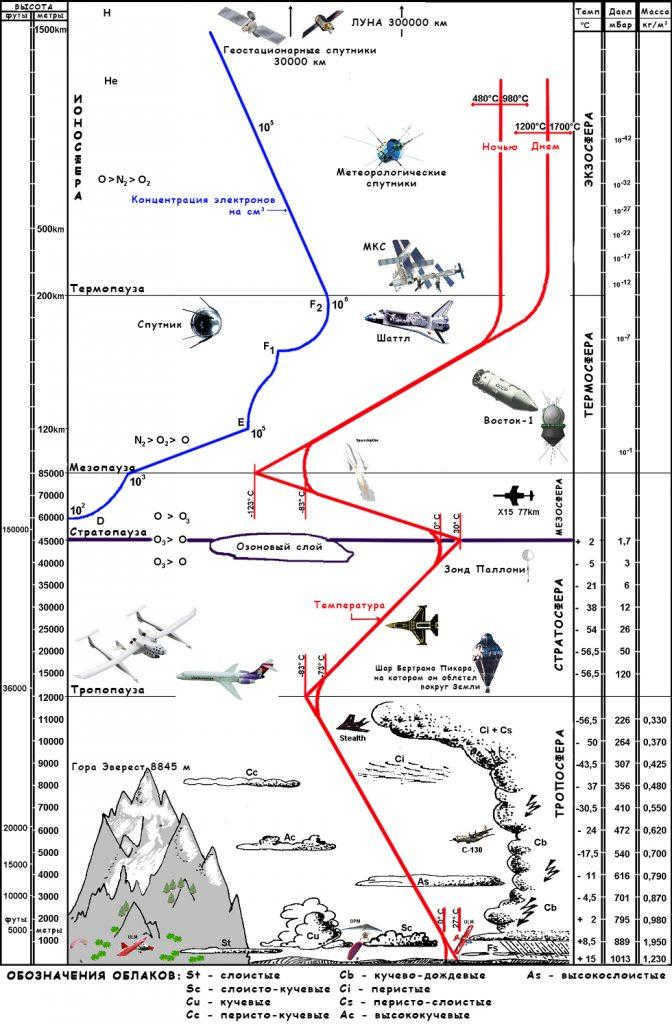
Troposphere
The troposphere is the lowest layer of the atmosphere, and its thickness varies depending on location. At the poles, it has a thickness of 8-10 km, at temperate latitudes it is 10-12 km, and at the equator, it reaches 16-18 km.
This layer of the atmosphere is primarily heated by the Earth’s surface, including land and water. As you move higher in the troposphere, the temperature decreases. On average, the temperature drops by 0.6 °C for every 100 m of altitude. At the upper boundary of the troposphere, the temperature can reach as low as -55 °C. However, at the equator, the temperature at the upper boundary can drop to -70 °C, and at the North Pole, it can reach -65 °C.
About 80% of the atmosphere’s mass is concentrated in the troposphere. This layer also contains a majority of the water vapor, thunderstorms, storms, clouds, and precipitation. Additionally, it is responsible for vertical convection and horizontal wind movement.
We can state that the formation of weather primarily occurs in the troposphere.
Stratosphere
The stratosphere is a layer of the atmosphere that sits above the troposphere, ranging in altitude from 8 to 50 km. The sky in this layer appears violet due to the rarefaction of air, which causes minimal scattering of sunlight.
With 20% of the atmosphere’s mass, the stratosphere is characterized by thin air and lacks significant amounts of water vapor, resulting in minimal cloud formation and precipitation. However, the stratosphere does experience stable air currents, with speeds reaching up to 300 km/h.


This particular region is where the ozone layer is located. It is the very layer of ozone that absorbs ultraviolet rays, preventing them from reaching the Earth’s surface and protecting living organisms on our planet. Thanks to the presence of ozone, the temperature of the air at the upper boundary of the stratosphere ranges from -50 to -55 °C.
Between the mesosphere and the stratosphere, there exists a transitional zone known as the stratopause.
Mesosphere
Actually, the mesosphere begins at an altitude of 50 km. Its upper limit is located at 80-90 km. Scientific evidence shows that the temperature in the mesosphere decreases as altitude increases. However, the dominant factor in this region is radiant heat exchange. Additionally, intricate photochemical reactions contribute to the phenomenon of Earth’s atmospheric glow.
The mesosphere accounts for less than 0.3% of the total mass.
Above the mesosphere, at an elevation of 100 kilometers above sea level, lies the Karman line – the conventional demarcation between the Earth and outer space. While there are gases present in this region that move in sync with the Earth and technically fall within the atmosphere, their quantity beyond the Karman line is relatively minuscule. Thus, any journey surpassing an altitude of 100 kilometers is already classified as a spaceflight.
The lower boundary of the thermosphere, the longest layer of the atmosphere, coincides with the Karman line. It extends up to a height of 800 kilometers and is exceptionally hot – at 400 kilometers, temperatures can soar to a maximum of 1800°C!


That’s scorching! When the temperature reaches 1538°C, iron starts to liquefy. However, spacecraft remain unaffected in the thermosphere. How is this possible? It’s due to the incredibly low concentration of gases found in the upper atmosphere – the pressure in the middle of the thermosphere is one million times less than the air concentration near the Earth’s surface! Although individual particles possess high energy, the vast distance between them creates a vacuum-like environment for the spacecraft. Nevertheless, this does not assist in dissipating the heat generated by the mechanisms – all spacecraft are equipped with radiators to release excess energy.
Exosphere
The exosphere, situated above 1000 km, is the outermost layer of the atmosphere. It is often referred to as the dispersion sphere due to the high-speed movement of gas particles, which can be scattered into outer space.
The exosphere of the Earth is remarkably vast, extending into the Earth’s corona known as the geocorona, which reaches a distance of up to 100,000 kilometers from the planet. The exosphere is extremely tenuous, with particle concentration millions of times lower than that of regular air. Nonetheless, if a distant spacecraft were to be obstructed by the Moon, the corona of our planet would become visible, much like how we observe the Sun’s corona during a solar eclipse. However, this phenomenon has yet to be observed.
Furthermore, it is within the exosphere where the Earth’s atmosphere undergoes erosion – due to its substantial distance from the planet’s gravitational center, particles easily disengage from the overall gas mass and enter their own orbits. This occurrence is referred to as atmospheric dissipation. Every second, our planet sheds 3 kilograms of hydrogen and 50 grams of helium from its atmosphere. These particular particles are the only ones light enough to separate from the collective gas mass.
Basic calculations reveal that the Earth relinquishes roughly 110,000 tons of atmospheric mass annually. Does this pose a threat? In reality, it does not – our planet’s capacity to “generate” hydrogen and helium surpasses the rate of depletion.
Water on Earth is not limited to the vast ocean and numerous rivers. The atmosphere actually contains about 5.2 ×10^15 kilograms of water. This water vapor is present in almost every location, with its concentration in the air ranging from 0.1% to 2.5% depending on temperature and location. However, the majority of the water is stored in clouds, where it exists not only as a gas, but also as small droplets and ice crystals. The concentration of water in clouds can reach up to 10g/m3. Some clouds can have volumes of several cubic kilometers, containing tens and even hundreds of tons of water.
Significance of the Earth’s Atmosphere
The Earth’s atmosphere, despite being the lightest geosphere, plays a vital role in numerous Earthly processes.
First and foremost, it is the atmosphere that enables the emergence and sustenance of life on our planet. Oxygen is indispensable for modern animals’ respiration, while carbon dioxide is essential for most plants, algae, and cyanobacteria. Animals rely on oxygen for their breathing, while plants utilize carbon dioxide in the process of photosynthesis, which produces complex organic compounds crucial for their growth and functionality, such as various carbon compounds, carbohydrates, amino acids, and fatty acids.
As we ascend in elevation, the partial pressure of oxygen starts to decline. This implies that there are diminishing amounts of oxygen atoms in every unit of volume. Once we reach an elevation of 3 km above sea level, the majority of individuals start to encounter oxygen deprivation or hypoxia. Symptoms of hypoxia include difficulty breathing, an elevated heart rate, lightheadedness, ringing in the ears, headaches, nausea, muscle weakness, perspiration, blurry vision, and drowsiness. Overall performance is significantly hindered. At elevations exceeding 9 kilometers, it becomes impossible for humans to breathe naturally, making it absolutely prohibited to be without specialized breathing apparatus.
Crucial to the normal functioning of living beings on Earth is the atmosphere’s role as a shield, safeguarding our planet against the Sun’s ultraviolet and X-ray radiation, cosmic rays, and meteors. The majority of this radiation is captured by the higher layers of the atmosphere, namely the stratosphere and mesosphere. As a result, fascinating electrical phenomena like auroras occur. The remaining, smaller portion of radiation is dispersed. Additionally, meteors, which we commonly perceive as tiny “shooting stars,” disintegrate in the upper atmosphere.
The heating of different areas on Earth is not uniform. The regions near the equator, known as the low latitudes, experience much greater solar heating compared to the middle and high latitudes, where temperate and Arctic (Antarctic) climates prevail. The heating patterns also vary between continents and oceans. While continents heat up and cool down relatively quickly, oceans have the ability to absorb heat for extended periods of time and release it gradually. It is a well-known fact that warm air rises, as it is lighter than cold air. Consequently, colder, denser air descends to fill the void left by the rising warm air. This movement of air is responsible for the formation of wind and subsequent weather patterns. The wind, in turn, plays a significant role in physical and chemical weathering processes, which ultimately shape the Earth’s external landforms.





